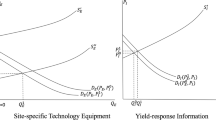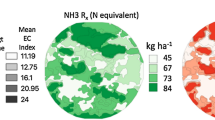Abstract
Technology adoption in precision agriculture has received considerable attention, while abandonment has received little. Survey data are now available to evaluate adoption and abandonment decisions. Understanding the factors motivating technology adoption and abandonment has implications for educational efforts directed toward improving the efficiency of production inputs and for research and development to improve the value of precision agriculture technologies. The objective of this research was to identify factors motivating the adoption and abandonment of grid soil sampling in precision cotton production. These decisions were evaluated assuming a random utility model. Data were obtained from a 2005 survey of cotton producers in 11 Southeastern states in the USA. Results from limited dependent variable regressions indicate that younger producers who farmed more cotton area, owned more of their cropland, planted larger amounts of non-cotton area, used a computer for farm management and used a Personal Digital Assistant (PDA) in the field were more likely to adopt grid soil sampling for cotton precision farming. Results also suggest that producers with more cotton area who owned livestock and adopted management zone soil sampling were more likely to abandon grid soil sampling, while those who used a PDA in the field, used grid soil sampling for more years and followed up grid soil sampling with variable-rate fertilizer application were less likely to abandon grid soil sampling for cotton production.
Similar content being viewed by others
References
Adamchuk, V. I., Hummel, J. W., Morgan, M. T., & Upadhyaya, S. K. (2004a). On-the-go sensors for precision agriculture. Computers and Electronics in Agriculture, 44, 77–91.
Adamchuk, V. I., Morgan, M. T., & Lowenberg-DeBoer, J. (2004b). A model for agro-economic analysis of soil pH mapping. Precision Agriculture, 5, 111–129.
Amponsah, W. A. (1995). Computer adoption and use of information services by North Carolina commercial farmers. Journal of Agricultural and Applied Economics, 27, 565–576.
Barham, B. L., Foltz, J., Jackson-Smith, D., & Moon, S. (2004). The dynamics of agricultural biotechnology adoption: Lessons from rBST use in Wisconsin, 1994–2001. American Journal of Agricultural Economics, 86, 61–72.
Batte, M. T., Jones, E., & Schnitkey, G. D. (1990). Computer use by Ohio commercial farmers. American Journal of Agricultural Economics, 72, 935–945.
Carletto, C., de Janvry, A., & Sadoulet, E. (1999). Sustainability in the diffusion of innovations: Smallholder nontraditional agro-exports in Guatemala. Economic Development and Cultural Change, 47, 345–369.
Daberkow, S. G., & McBride, W. D. (2003). Farm and operator characteristics affecting the awareness and adoption of precision agriculture technologies in the US. Precision Agriculture, 4, 163–177.
Dillon, C. R., Stombaugh, T. S., Kayrouz, B., Salim, J., & Koostra, B. K. (2007). An educational workshop on the use of precision agriculture as a risk management tool. In J. Stafford (Ed.), Proceedings of the 6th European conference on precision agriculture (pp. 861–867). The Netherlands: Wageningen Agricultural Press.
Fernanadez-Cornejo, J., Beach, E. D., & Huang, W. (1994). The adoption of IPM techniques by vegetable growers in Florida, Michigan, and Texas. Journal of Agricultural and Applied Economics, 26, 158–172.
Foltz, J. D., & Chang, H. (2002). The adoption and profitability of rbST on Connecticut dairy farms. American Journal of Agricultural Economics, 84, 1021–1032.
Greene, W. H. (2000). Econometric analysis. Upper Saddle River, New Jersey, USA: Prentice Hall.
Heckman, J. J. (1976). The common structure of statistical models of truncation, sample selection and limited dependent variables and a sample estimator for such models. Annals of Economic and Social Measurement, 5, 475–492.
Khanna, M. (2001). Sequential adoption of site-specific technologies and its implications for nitrogen productivity: A double selectivity model. American Journal of Agricultural Economics, 83, 35–51.
Larson, J. A., & Roberts, R. K. (2004). Farmers’ perceptions of yield variability as influenced by precision farming information gathering technologies. Paper presented at the annual meeting of the Southern Agricultural Economics Association, Tulsa, OK, USA, February 14–18. http://ageconsearch.umn.edu/bitstream/34600/1/sp04la01.pdf. Accessed October 2009.
Lentner, M., & Bishop, T. (1993). Experimental design and analysis. Blacksburg, VA, USA: Valley Book Company.
Lowenberg-DeBoer, J., & Aghib, A. (1999). Average returns and risk characteristics of site-specific P and K management: Eastern corn belt on-farm trial results. Journal of Production Agriculture, 12(2), 276–282.
Maddala, G. S. (1988). Introduction to econometrics. New York, USA: Macmillan Publishing Company.
Rivers, D., & Vuong, Q. H. (1988). Limited information estimators and exogeneity tests for simultaneous probit models. Journal of Econometrics, 39, 347–366.
Roberts, R. K., English, B. C., Larson, J. A., Cochran, R. L., Goodman, W. R., Larkin, S. L., et al. (2004). Adoption of site-specific information and variable-rate technologies in cotton precision farming. Journal of Agricultural and Applied Economics, 36, 143–158.
Roberts, R. K., English, B. C., Larson, J. A., Cochran, R. L., Larkin, S. L., Marra, et al. (2006). Use of precision farming technologies by cotton farmers in 11 states. In P. Dugger & D. Richter (Eds.), Proceedings Beltwide Cotton Conference (pp. 288–295). National Cotton Council of America, Memphis, TN, USA.
Rogers, E. M. (1983). Diffusion of innovations. New York, USA: Free Press.
Swinton, S. M., & Jones, K. Q. (1998). From data to information: The value of sampling vs. sensing soil data. Department of Agricultural Economics, Staff paper 98–15. Michigan State University, East Lansing, MI, USA.
Swinton, S. M., & Lowenberg-Deboer, J. (1998). Evaluating the profitability of site specific farming. Journal of Production Agriculture, 11, 439–446.
U.S. Department of Agriculture, Economic Research Service (USDA-ERS). (2007). Farm resource regions. http://www.ers.usda.gov/Publications/aib760/aib-760.pdf. Accessed September 2009.
Walton, J. C., Lambert, D. M., Roberts, R. K., Larson, J. A., English, B. C., Larkin, S. L., et al. (2008). Adoption and abandonment of precision soil sampling in cotton production. Journal of Agricultural and Resource Economics, 33, 428–448.
Whipker, L. D., & Akridge, J. T. (2006). 2006 precision agricultural services dealership survey results. Department of Agricultural Economics, Staff Paper #06–10, Purdue University, West Lafayette, IN, USA.
Wooldridge, J. (2002). Econometric analysis of cross section and panel data. London, UK: MIT Press.
Wooldridge, J. (2006). Introductory econometrics. Ohio, USA: Thomson South-Western.
Author information
Authors and Affiliations
Corresponding author
Rights and permissions
About this article
Cite this article
Walton, J.C., Roberts, R.K., Lambert, D.M. et al. Grid soil sampling adoption and abandonment in cotton production. Precision Agric 11, 135–147 (2010). https://doi.org/10.1007/s11119-009-9144-y
Published:
Issue Date:
DOI: https://doi.org/10.1007/s11119-009-9144-y




